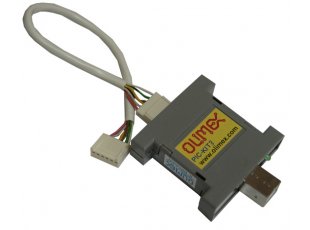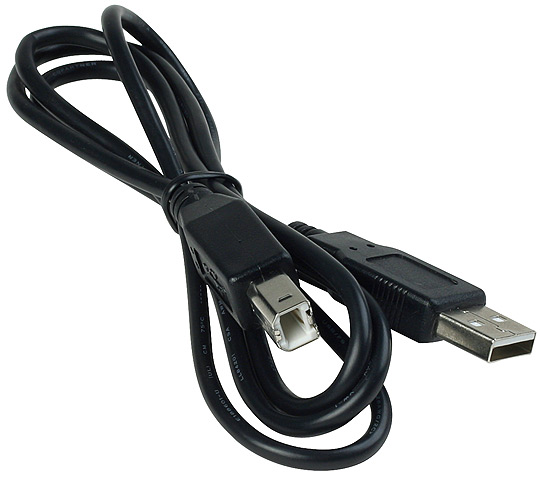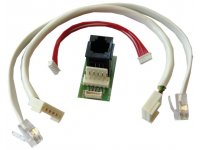≡

PIC-KIT3

Low-cost programmer / debugger
| Price | 29.95 EUR |
|---|---|
| 10 - 49 pcs | 26.96 EUR |
| 50 - 10000 pcs | 23.96 EUR |
PIC-KIT3 is a low cost programmer/debugger. With its 55 x 55 mm (2.16 x 2.16") dimensions and only 30 grams of weight (excluding the ICSP cable and packing). This little device fits your pocket and is very convenient to carry around when working in field. The PIC-KIT3 is a complete replacement of the Microchip's original PICkit3 and with it you can do everything you could do with the original PICkit3.
FEATURES
- USB (Full Speed 2 M bits/s) interface to host PC
- Real-time background debugging
- MPLAB and MPLAB X compatible (latest release available for free download from Microchip's web site)
- Built in over-voltage/short circuit monitor
- Firmware upgradeable from PC
- Supports low voltage to 2.0 volts. (2.0 to 6.0 range)
- Diagnostic bi-color LED (Busy, Error)
- External power jack (6-9VDC) for standalone programming
- Programmer-to-go function
- Reading/Writing memory space and EEDATA areas of target microcontroller
- Programs configuration bits
- Can erase program memory space with verification
- Peripheral freeze-on-halt stops timers at breakpoints
DOCUMENTS
HARDWARE
PIC ICSP connector (top view)
SOFTWARE
MPLAB-IDE - you can download the latest version from Microchip's web site.
FAQ
- What USB cable do I need?
- You should have a USB type A-B cable to connect to a PC. All PC USB hosts have a USB-A connector while the PIC-KIT3 has a USB-B connector so the cable should be a USB A-to-B type. Note that such a cable is not included in the package.
- Hello, I attempted to use PIC-KIT3 and then the connection failed. After this the PIC-KIT3 gets listed with exlcamation mark in "Windows Device Manager" and reports the error - "This device cannot start. (Code 10)". What is the problem? What should I do?
- This problem might appear after a failed firmware update. The firmware update might fail due to different reasons. It happens more frequently when you often change the versions of MPLAB that you use (the latest PIC-KIT3 firmware versions in MPLAB 8 differ a lot from the latest PIC-KIT3 firmware versions in MPLAB X or MPLAB IPE).
There is a fix for this problem - enter bootloader mode - disconnect the PIC-KIT3 from the USB; press and hold the small black button (programmer-to-go button); connect the PIC-KIT3 to the USB; release the button. Then open MPLAB or MPLAB IPE and attempt the connection again. Make sure you are using latest version of MPLAB IDE or MPLAB IPE.
If the connection still fails re-try the procedure at least few more times. Then try to manually download the firmware (again enter bootloader mode using the button) and then go to "Settings" -> "Manual Download Firmware". In MPLAB IPE you would need first enable "Advanced Mode" before being able to select "Manual Download Firmware". There is a strict time window after releasing the button that the board can be accessed, so give it a few tries.
Test the same procedure (to manually download the firmware) without entering bootloader mode - use a standard connect procedure (do not hold the button).
Finally, test the above fixes with another MPLAB version. For example, if you have used MPLAB 8, try with the latest MPLAB IPE; or if you have used MPLAB IPE, then try with MPLAB 8.92.
Sometimes closing-opening the software would allow you to perform the firmware update. Sometimes you would need to try 2 or 3 times until it succeeds.
- Hello, I use both MPLABX and MPLAB 8.xx. Recently, the "programmer-to-go" to go function stopped working in MPLAB 8, everything else works fine. The error I get is: "PK3Err0033: 4 bytes expected, 0 bytes received". What can I do?
- This is a known problem that affects both the original Microchip PICKit3 and Olimex PIC-KIT3. It was caused by the newest firmware released. Most typically the problem appears after you have used new version of MPLAB X or MPLAB IPE. You PIC-KIT3 got automatically upgraded with a firmware version that is no longer compatible with MPLAB 8. The versions incompatible with MPLAB 8 are firmware versions 1.3x.xx and newer (1.35.16, for example). With such a firmware you will not be able to make proper connections to targets after an AP update nor you would be able to use programmer-to-go in any MPLAB prior ot MPLAB X. The PIC-KIT3 would still work fine in MPLABX and MPLAB IPE (and the programmer-to-go would also work fine).
So if you want to use MPLAB 8 you would need to manually revert to firmware version 1.28.90 (or any 1.2x.xx version). This can be done in MPLAB 8:
1. Navigate to Programmer -> Select Programmer -> PICKit3
2. Deal with any pop up message making sure there is some power to the PIC-KIT3; ignore any reports for errors they doesn't matter at this point
3. Navigate to "Programmer" -> "Settings" (at the bottom); click "Configuration" tab; Disable "Auto Download Latest Firmware" and click "Manual Download". Point the pop-up to PK3FW_012890.jam (or similar as long as it is is located in the MPLAB 8 folders), by default located in C:\Program Files (x86)\Microchip\MPLAB IDE\PICkit 3. Click "OK" and wait for upload.
4. If there are problems or the update takes more than a few minutes disconnect the PIC-KIT3 from the USB, connect it again and try the firmware update again. The procedure would refuse to work sometimes if you don't reset the connection (by unplugging and pugging the PIC-KIT3 again).
5. Upon successfull revert you would see "Firmware Suite Version...... 01.28.90" instead of "Firmware Suite Version...... 01.35.16".
Now you can use MPLAB 8 as previously and the programmer-to-go button would work.
- What should I know when connecting the PIC-KIT3 to a target board?
- It's very important that your target PIC MCLR is not connected directly to the VCC!
During programming/debugging MCLR goes as high as 13VDC and if your target MCLR is connected directly to the target VCC, you will blow either the PIC-KIT3 or the target board. Always use a 10K pullup resistor from MCLR to VCC.
- What are the LEDS for?
- There are two LEDS – one yellow LED named ACTIVE and one double-color LED named STAT (red/green colors). The yellow LED shows USB activity – e.g. when the device is connected to the USB properly; when you are powering the board from an external source via the power jack this LED would blink. The STAT LED shows RED color when you are connected to MPLAB or the image inside the EEPROM is ready for operation. When there is programming data is transferred, the double LED should blink in an orange color (red and green).
- Hello, I pressed the "programmer-to-go" button and my PIC32 died. What burned my chip?
- Do not use the "programmer-to-go" button when there is no image in the OLIMEX PIC-KIT3 or MICROCHIP PIC-KIT3 because that might put your microcontroller in an irrecoverable state. We have tested the mentioned scenario and we can confirm that it destroys the PIC32 chips (using both our and the original Microchip PICKIT3). We don't take responsibility if you break your chip that way. For more info check the following: www.microchip.com/forums/m635420.aspx.




